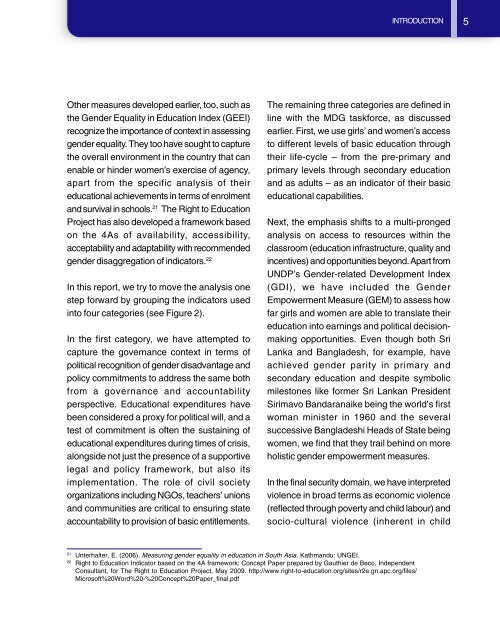Cover(final) - United Nations Girls' Education Initiative
Cover(final) - United Nations Girls' Education Initiative
Cover(final) - United Nations Girls' Education Initiative
Create successful ePaper yourself
Turn your PDF publications into a flip-book with our unique Google optimized e-Paper software.
INTRODUCTION 5<br />
Other measures developed earlier, too, such as<br />
the Gender Equality in <strong>Education</strong> Index (GEEI)<br />
recognize the importance of context in assessing<br />
gender equality. They too have sought to capture<br />
the overall environment in the country that can<br />
enable or hinder women’s exercise of agency,<br />
apart from the specific analysis of their<br />
educational achievements in terms of enrolment<br />
and survival in schools. 21 The Right to <strong>Education</strong><br />
Project has also developed a framework based<br />
on the 4As of availability, accessibility,<br />
acceptability and adaptability with recommended<br />
gender disaggregation of indicators. 22<br />
In this report, we try to move the analysis one<br />
step forward by grouping the indicators used<br />
into four categories (see Figure 2).<br />
In the first category, we have attempted to<br />
capture the governance context in terms of<br />
political recognition of gender disadvantage and<br />
policy commitments to address the same both<br />
from a governance and accountability<br />
perspective. <strong>Education</strong>al expenditures have<br />
been considered a proxy for political will, and a<br />
test of commitment is often the sustaining of<br />
educational expenditures during times of crisis,<br />
alongside not just the presence of a supportive<br />
legal and policy framework, but also its<br />
implementation. The role of civil society<br />
organizations including NGOs, teachers’ unions<br />
and communities are critical to ensuring state<br />
accountability to provision of basic entitlements.<br />
The remaining three categories are defined in<br />
line with the MDG taskforce, as discussed<br />
earlier. First, we use girls’ and women’s access<br />
to different levels of basic education through<br />
their life-cycle – from the pre-primary and<br />
primary levels through secondary education<br />
and as adults – as an indicator of their basic<br />
educational capabilities.<br />
Next, the emphasis shifts to a multi-pronged<br />
analysis on access to resources within the<br />
classroom (education infrastructure, quality and<br />
incentives) and opportunities beyond. Apart from<br />
UNDP’s Gender-related Development Index<br />
(GDI), we have included the Gender<br />
Empowerment Measure (GEM) to assess how<br />
far girls and women are able to translate their<br />
education into earnings and political decisionmaking<br />
opportunities. Even though both Sri<br />
Lanka and Bangladesh, for example, have<br />
achieved gender parity in primary and<br />
secondary education and despite symbolic<br />
milestones like former Sri Lankan President<br />
Sirimavo Bandaranaike being the world’s first<br />
woman minister in 1960 and the several<br />
successive Bangladeshi Heads of State being<br />
women, we find that they trail behind on more<br />
holistic gender empowerment measures.<br />
In the <strong>final</strong> security domain, we have interpreted<br />
violence in broad terms as economic violence<br />
(reflected through poverty and child labour) and<br />
socio-cultural violence (inherent in child<br />
21<br />
Unterhalter, E. (2006). Measuring gender equality in education in South Asia. Kathmandu: UNGEI.<br />
22<br />
Right to <strong>Education</strong> Indicator based on the 4A framework: Concept Paper prepared by Gauthier de Beco, Independent<br />
Consultant, for The Right to <strong>Education</strong> Project, May 2009. http://www.right-to-education.org/sites/r2e.gn.apc.org/files/<br />
Microsoft%20Word%20-%20Concept%20Paper_<strong>final</strong>.pdf

















